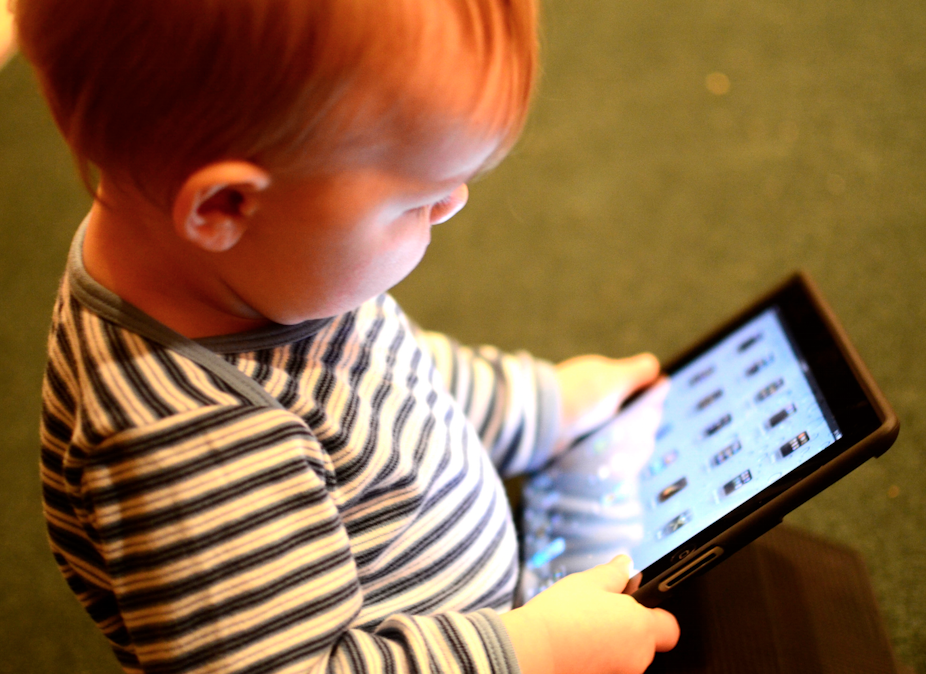Screen time – watching television, DVDs, or using other electronic media devices such as mobile phones and iPads – is now a major part of our daily lives. It is virtually impossible to avoid exposure to these technologies. Yet that is exactly what the Department of Health and Ageing in Australia recommends for children younger than two years of age.
This recommendation is based on guidelines set by the American Academy of Pediatrics in 1999, which it now says could be obsolete in the digital age. The academy did an update in 2011 but the recommendations remained largely unchanged.
There is no question that excessive screen time can have negative impacts on children’s sleep as well as development more generally. But is there sufficient evidence that screen time should be completely eradicated in this age group, as these guidelines indicate?
The Australian guidelines make several claims to support this recommendation. One is that screen time may leave less time for active play and social interaction with others. The other main claim is that there is no evidence that health, intellectual or language benefits are gained from screen-based activities in children under two years of age.
Therefore, with the possibility of adverse effects, combined with no benefits from screen time, the advice of no screen time for little ones would seem to make a lot of sense. But the situation is not that simple, and the evidence is not that clear.
There are some important aspects of these guidelines that bring into question the recommendations being made, particularly in Australia. Firstly, screen time and media use were discouraged for those under two years of age, which is in contrast to the very strict instruction of no screen time at all proposed in Australia.
This is an important distinction; discouraging and limiting electronic media use is a much more attainable goal than completely eradicating it from children’s lives.
Are the guidelines outdated?

These guidelines were developed a long time ago. They are predominantly based on activities such as television and pre-recorded video and DVD viewing. The fact that electronic media and the way it’s used has changed substantially since then seems to have been largely ignored by current recommendations.
When it comes to television viewing, there is some evidence that it may be negatively related to things such as obesity, behaviour and cognitive development.
This can be due to the content of what is being watched. Violent content in particular has been shown to have a negative impact on young children. Increased time viewing television has also been shown to leave less time for other potentially beneficial activities.
But just as the content and amount of screen time may produce negative outcomes, it is also true that these aspects may lead to positive outcomes too.
The next generation of screen time
With the next generation of screen-time devices, such as mobile phones and iPads, there are many features that make the use of these kinds of electronic media very different from earlier screen technologies.
Children are able to interact with these devices, which are able to respond to what a child does. They can be tailored to the developmental level of a child and can facilitate joint play and interaction with other children and adults. And they are portable, meaning they can be used in a wide variety of places and situations.
Research on the impact of these newer screen-based technologies on children’s development and well-being remains scarce. However, these distinguishing features bring into question whether they should be considered alongside other, more traditional screen technologies when setting guidelines.
The way in which these guidelines are set and communicated is also very important. Often there is limited or conflicting evidence regarding a risk or hazard, as is the case with screen time and young children. The Department of Health guidelines are not clear about the supporting information and evidence given for eliminating screen time.
People prefer to receive more information about how decisions are made so they are able to come to a clear and informed judgement. Therefore it’s not only the guideline itself that is important, but also the behind-the-scenes discussions of how such assessments are made.

Rethinking the guidelines
This month the American Academy of Pediatrics acknowledged some of the shortcomings in its original guidelines.
With new guidelines being developed, the discouragement of use below two years of age is being revised, with the content and context of screen time now being taken into account and prioritised over setting strict time limits. This is a very positive step forward. Let’s hope Australia and other countries with overly strict limits will follow suit.
Screen time isn’t necessarily bad. It’s a part of our everyday lives, and although negative impacts should not be ignored, nor should positive ones. We need to strike a balance by encouraging positive use of technology and limiting potentially harmful use. As the guidelines under development show, the way in which electronic media is used is more important than setting strict limits on its use.

